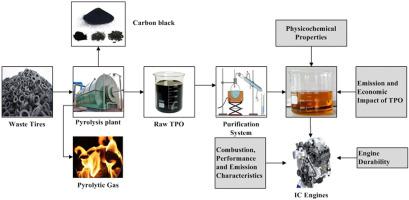Journal of the Energy Institute ( IF 5.6 ) Pub Date : 2021-03-10 , DOI: 10.1016/j.joei.2021.03.002 Haseeb Yaqoob , Yew Heng Teoh , Muhammad Ahmad Jamil , Mubashir Gulzar

|
The application of tire pyrolysis oil (TPO) as an alternative fuel has attained attention owing to the exponentially raise demand and price of fossil fuels, environmental impacts, and landfilling of the waste tires. Globally, the pyrolysis process has become the leading solution to this problem by converting the waste tires to the TPO. So, this review paper studies the application of TPO in diesel engines related to the purification and physicochemical properties of TPO with their effects on the combustion, performance, and emission characteristics of the fuel. Oxidative desulfurization and catalyst process is the most reliable method to remove the sulfur contents and purified the tire pyrolysis oil. Higher cylinder peak pressure, heat release rate, and ignition delay has been observed and noted its impact on the combustion analysis of the TPO. An increase in brake power, brake thermal efficiency, and lower brake specific fuel consumption have been found in the performance analysis of TPO. In emission analysis literature, mixed trends have been seen in nitrogen oxides and hydrocarbon emission, so in some cases, emission tends to increase, but the opposite direction has also been observed in other cases. Carbon monoxide and carbon dioxide and particulate matter emission are reduced owing to the excess of oxygen shares in TPO. In general, no alteration in the diesel engine is required for a low share of TPO in the TPO-diesel blend. Finally, it is concluded that the studies recommended the TPO-diesel (10%–90%) blend in the engine as an alternative fuel.
中文翻译:

轮胎热解油作为柴油发动机替代燃料的潜力:综述
由于对化石燃料的需求和价格呈指数级增长,对环境的影响以及废轮胎的填埋,轮胎热解油(TPO)作为替代燃料的应用受到了关注。在全球范围内,通过将废轮胎转换为TPO,热解工艺已成为解决该问题的主要方法。因此,这篇综述论文研究了TPO在柴油发动机中的应用,这些应用与TPO的提纯和理化特性有关,它们对燃料的燃烧,性能和排放特性有影响。氧化脱硫和催化剂工艺是去除硫含量和纯化轮胎热解油的最可靠方法。观察到较高的气缸峰值压力,放热率和点火延迟,并注意到其对TPO燃烧分析的影响。在TPO的性能分析中,已经发现制动功率,制动热效率的提高和制动比油耗的降低。在排放分析文献中,氮氧化物和碳氢化合物的排放存在混合趋势,因此在某些情况下排放趋于增加,但在其他情况下也观察到相反的方向。一氧化碳,二氧化碳和颗粒物的排放量由于TPO中过量的氧份额而减少。通常,由于在TPO-柴油混合物中TPO含量低,因此无需对柴油发动机进行任何改动。最后,得出的结论是,研究建议在发动机中混合使用TPO柴油(10%–90%)作为替代燃料。在TPO的性能分析中发现了更低的制动比油耗。在排放分析文献中,氮氧化物和碳氢化合物的排放存在混合趋势,因此在某些情况下排放趋于增加,但在其他情况下也观察到相反的方向。一氧化碳,二氧化碳和颗粒物的排放量由于TPO中过量的氧份额而减少。通常,由于在TPO-柴油混合物中TPO含量低,因此无需对柴油发动机进行任何改动。最后,得出的结论是,研究建议在发动机中混合使用TPO柴油(10%–90%)作为替代燃料。在TPO的性能分析中发现了更低的制动比油耗。在排放分析文献中,氮氧化物和碳氢化合物的排放存在混合趋势,因此在某些情况下排放趋于增加,但在其他情况下也观察到相反的方向。一氧化碳,二氧化碳和颗粒物的排放量由于TPO中过量的氧份额而减少。通常,由于在TPO-柴油混合物中TPO含量低,因此无需对柴油发动机进行任何改动。最后,得出的结论是,研究建议在发动机中混合使用TPO柴油(10%–90%)作为替代燃料。但是在其他情况下也观察到相反的方向。一氧化碳,二氧化碳和颗粒物的排放量由于TPO中过量的氧份额而减少。通常,由于在TPO-柴油混合物中TPO含量低,因此无需对柴油发动机进行任何改动。最后,得出的结论是,研究建议在发动机中混合使用TPO柴油(10%–90%)作为替代燃料。但是在其他情况下也观察到相反的方向。一氧化碳,二氧化碳和颗粒物的排放量由于TPO中过量的氧份额而减少。通常,由于在TPO-柴油混合物中TPO含量低,因此无需对柴油发动机进行任何改动。最后,得出的结论是,研究建议在发动机中混合使用TPO柴油(10%–90%)作为替代燃料。











































 京公网安备 11010802027423号
京公网安备 11010802027423号